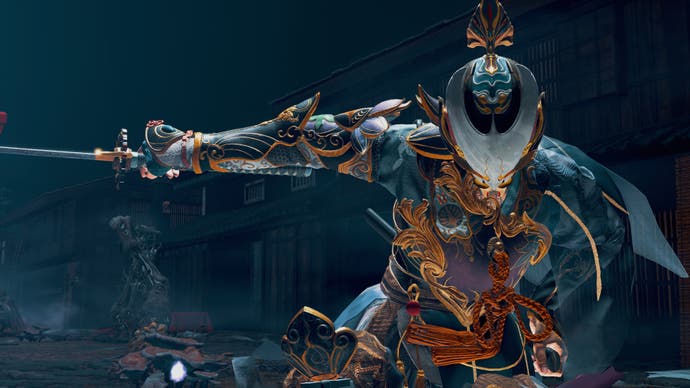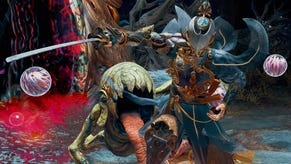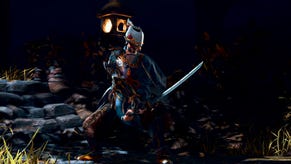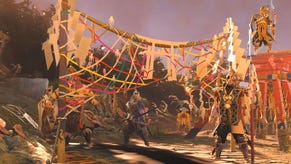Kunitsu-Gami: Path of the Goddess review - a heavenly blend of tactical action
Spirited away.
Cleansing the land of an ancient evil, purging its demon spawn in a flurry of Japanese artistry, and watching new life spring forth as nature returns to peace and harmony… Nope, I'm not talking about the brilliant inkwash battles of Okami, but the demon-slaying kagura dances of Kunitsu-Gami: Path of the Goddess. It is, in fairness, a connection that Capcom has increasingly leaned into in the run-up to Kunitsu-Gami's release. If the shared themes and free Amaterasu and Waka costumes for its deuteragonists Soh and Yoshiro weren't a sign that, yes, this is likely as close as we're ever going to get to a pseudo-spiritual successor to Clover Studio's 2006 romp through Japanese folklore, then the option to substitute Kunitsu-Gami's musical score for remixed Okami tracks surely seals the deal.
But to say Kunitsu-Gami is simply a sheep in this particular white and red wolf's clothing would also be doing it a great disservice. For underneath all the Ammy nostalgia, this is a finely crafted action strategy game that has both the brains and brawn to stand on its own, marrying fast and visually hypnotic swordplay combos with the cerebral plotting of quick-witted tower defence. Of course, this being Capcom, these towers aren't static objects to slap down and hope for the best. They're fellow villagers you can move about the battlefield and assign different roles and classes to in order to help you combat the waves of yokai monsters that pour out of torii gate portals every time the sun goes down. As Soh, your goal is to protect and escort the priestess Yoshiro toward these torii gates so she can banish their corrupting influence for good, though with the risk of defeat ratcheting up the closer you get to victory, you'll need to do plenty of thinking on your feet to help win the day.
The expert pacing of Kunitsu-Gami is arguably what binds it altogether. Thanks to the inherent ticking clock of its day-night cycle (beautifully portrayed as a reflection of the sun arcing round a bowl of water), each individual level rarely exceeds 10-15 minutes in length. These bursts of concentrated action make your days feel tense and urgent as you make your preparations, but sharp and punchy when nightfall comes and you battle the menacing Seethe monsters. Combat isn't simply about living to see a new dawn either. With every Seethe defeated, you'll collect crystals that can be ploughed back into assigning your villagers new roles if you need to switch up your strategy, as well as carving a path for Yoshiro so she can shimmy up to the big torii gate at the end of level to perform her cleansing ritual.


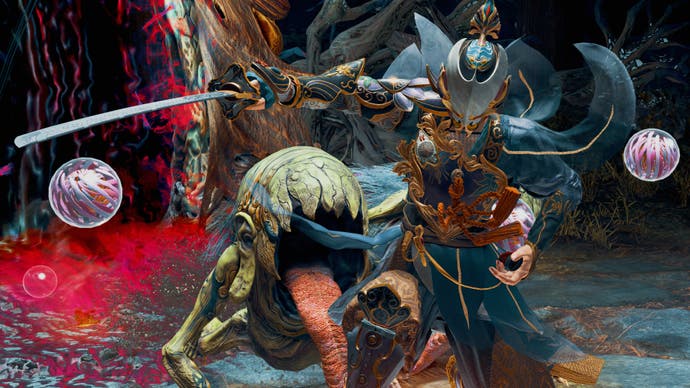
The path Yoshiro treads is always fixed, but that doesn't make defending it any easier. Seethe will eventually pour out of all manner of torii gates strewn around the wreckage, and helpful buff totems, demon nets and long-range tower platforms that might help give you a leg up against the hordes are always placed just far enough off the beaten track to prevent you from relying on any easy turtling options. This is a game that constantly encourages you to go beyond what feels comfortable, pushing players to take risks with their defence strategies and try new options as you inch further and further toward your goal.
These structures don't come ready-made off the bat, however. The Seethe have properly razed these tiny mountainside communities, and you'll need to add managing the limited time of your trusty carpenter to get them built and repaired during the day to all the other things you've got to juggle. There are too many to repair all at once, so you'll need to pick and choose what will be most helpful to you. I love this kind of pressure-cooker preparation, and by the time I'd got halfway through its 16 levels, I was even honing my daytime laps of the village to be as efficient as possible, trying not to waste a second as I tracked down those last remaining trapped villagers to enlist into my ranks, chased after its corrupted wildlife to swipe extra health-boosting rations, and wipe out every last defilement spot so I could unlock that level's unique treasure.

For others, of course, that might sound like hell. But Kunitsu-Gami isn't really a game about sweating the small stuff. An active pause lets you rearrange your warriors on the fly, and you're able to reassign roles as many times as you like, provided you've got the crystals to do so. There's a lot of freedom in how you can approach each nightly battle, and the spaces Kunitsu-Gami creates for you have the air of one big tactical playground after another to experiment in. There's no 'wrong way' to play Kunitsu-Gami, and for me, that makes all the decisions that did pan out feel extra satisfying, as they were mine and mine alone, and not the result of me trying to play to prescribed expectations.
It also just throws a heck of a lot of stuff at you to keep you on your toes. New enemy types are layered in one mission at a time, and new roles for your villagers are unlocked after each new boss battle you encounter (which, admittedly, are more concentrated in the first half of the game, but do still keep on coming right up until the final boss gauntlet). What's more, the levels themselves have such a spread of unique ideas that there's always some fresh spanner in the works that you're constantly having to adapt and adjust to.
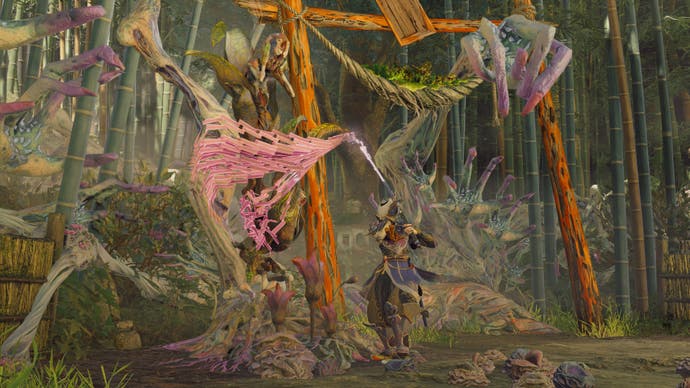

It's astonishing how much it keeps piling onto your plate early on, almost to the point where you think that any second now, it's all going to collapse in front of you. But Kunitsu-Gami's foundations have all the strength you'd expect from a Capcom-led production. Indeed, if you're not learning how one of its many carpenter constructions fit into its wider tactical puzzle, then you're having to contend with the environment itself (and often both at the same time). Mt Kafuku is a wonderfully realised setting in Kunitsu-Gami, and its groves, villages, swamps, rivers, lakes and caves all manage to tread that line between natural-feeling locales plucked from a real-life mountain trail and designed spaces that are brimming with tactical possibilities.
The caves, for example, must be kept lit with snuff-able lanterns in order for your villagers to see the Seethe in front of them, while the lake sees you fighting across multiple tethered boats as you travel to the other side. Its marshes are also riddled with ominous poison swamps that drain your health, while the path through a larger agricultural settlement will fork and diverge, making you pick one route over another. And that's before we get to the giant cherry blossom tree that carves the arena in half when a hidden boss bursts out of it, as well as the stages that either leave you completely bereft of your villagers, or your villagers bereft of you. There's never a dull moment, in other words, and when Kunitsu-Gami does reuse a small smattering of its ideas toward the end of the game (though never more than once per idea), they don't ever feel like rehashes of what came before. Rather, in that lovely kind of Nintendo way, their challenges evolve to meet the wider variety of villager roles now available to you, and the greater numbers of monster types you know how to handle.
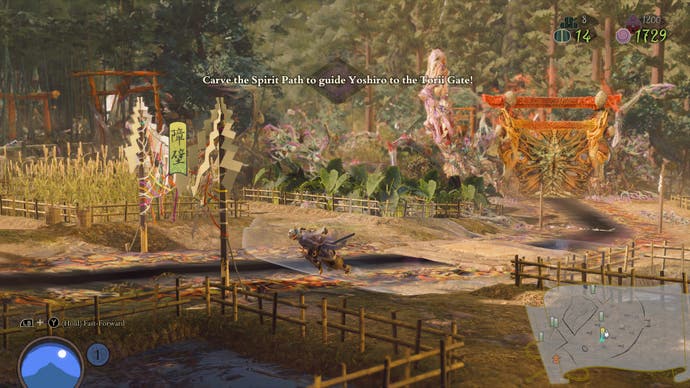
Soh, too, gains a whole new dancing style and ability tree just after the game's mid-point, letting you exchange their soaring katana arcs and graceful sword leaps for a sharper, more punctuated stabby style. Thankfully, it has all the same button combos so you won't have to undo any ingrained muscle memory here, but onscreen, its rhythms do feel different enough to warrant it being its own tactical toolset. In some ways, it's a shame that Kunitsu-Gami doesn't do more with it, as none of its enemies are weak against one style or the other. This is somewhat understandable, as your dancing style along with your loadout of various trinkets and talismans must all be decided in advance before committing to a particular stage, and it would be cruel indeed to find yourself up against an enemy that required the opposite fighting style to the one you've got equipped. It's a minor blip in the grand scheme of things, though, and it doesn't detract whatsoever from its moment-to-moment action.
One thing that may become more of a sticking point, though, is Soh's parry, which feels like a bit of an afterthought rather than a considered part of their arsenal. I should stress, it's by no means essential to Kunitsu-Gami's overall combat, and this is really the most nit-picky of nitpicks. But while there is a rudimentary lock-on of sorts here, it's only really for aiming Soh's unlockable bow, whose arrows will land automatically regardless of whether Soh's facing the correct direction. Soh won't lock eyes with the enemy your targeting, and the camera remains a completely free agent on the right thumbstick, making it difficult to know if you're even facing the right direction for a well-timed block when you're right up in the thick of it, let alone perfect the timing of it.
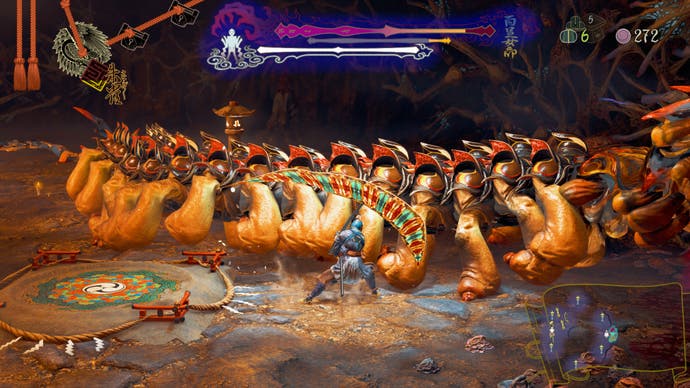


Thankfully, this is not a combat system that's built around expert button presses, and you don't really need to give it a second thought even when things get heated. Still, it can't help but remind you of what might have been, given Capcom's action pedigree. It's almost like Capcom can't help themselves when it comes to making a great-feeling action hero, but you shouldn't go in expecting Soh to be some secret Dante who can wipe the floor with the Seethe on their lonesome. Their attacks - while visually stunning with their trails of kaleidoscopic colours - are deliberately quite simple, extending to nothing more complicated than mashing X-X-X-Y, with no real need for any rhythmic timing. Presumably, it's so you've got enough mental bandwidth for all the tactical stuff you've got to think about as well. But in those moments where you're one on one with a boss and all you can do is pound the same combos over and over, you can't help but yearn for something a little juicier to sink your teeth into.
Still, for the most part, it's your villagers that pick up the shortfall here, and there are some brilliantly fun archetypes to play around with. You get to form a new crew with each new level, and while you begin with basic melee woodcutters and long-distance archers, you're quickly weighing up the cost of having a tank-y sumo wrestler in your squad or a healing shaman, or slower, but more powerful spear and riflemen to replace your cheaper starter units. Later, you can enlist powerful sorcerers, who might take the entire night to warm up their vocal chords, but man alive they sure can belt it out like a fist straight from the heavens once they're fully charged. The best is saved for last, too, which I won't spoil, but even with this eleventh hour addition and the end of the game in sight, I did feel a strong urge to go back and test them out on some earlier levels to try and hit some of Kunitsu-Gami's extra challenge targets (and with even more challenges available in New Game+, there's certainly no shortage of opportunities to really put them through their paces).
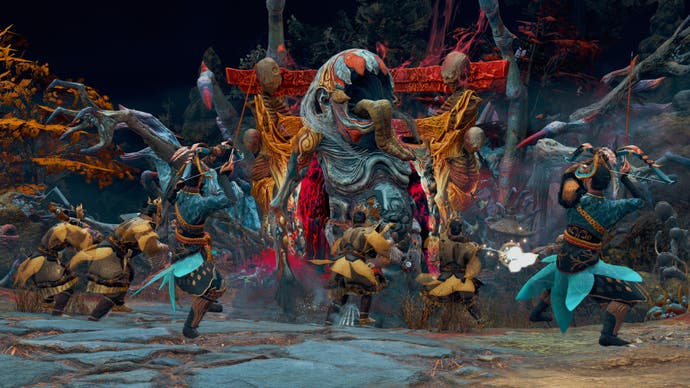
Away from battle, you can also revisit each level in its cleansed 'base mode', where you can assign villagers to rebuild its infrastructure to gain bonus rewards, including upgrade points for Soh and your villager roles, as well as the option to stretch the limits of your crystal purse and ration wallet once repairs are fully complete. Sure, the actual process of rebuilding is quite basic. Rather than villagers having any particular proficiencies or traits to help them build things faster, say, all you need to do is assign the requisite number of people for that job, go away and complete one or (for big projects) two stages, then return to reap your rewards. It's a gentle, if rather untaxing kind of reward loop, and one of the few places where you can feel the slight pudge of padding in Kunitsu-Gami's otherwise extremely lean musculature. Still, it does provide a welcome respite from the constant, always-on action of its battle stages, and completing a town's repairs also feels like a vital stepping stone to really letting you unlock the potential of Kunitsu-Gami's best (and most expensive) toys.
Ultimately, though, even the rare occasions where Kunitsu-Gami does falter in its footwork, they're minor missteps rather than full-blown blunders. There's a wild, but assured confidence in the way it throws itself so wholeheartedly into its blend of tactical action, and it trusts its players to follow suit, giving them a suite of tools to use as they see fit, and a freeform approach to strategic decision making that makes each victory feel uniquely earned and deserved. There is so much life and energy to this game that it just feels infectious from the off, from its exquisitely animated heroes and monsters to its propulsive score and creative twists on its two genres. Yes, there will be some who'll only want to howl for more Okami when all is said and done, but Kunitsu-Gami: Path of the Goddess more than deserves its own place in the Capcom pantheon.
A copy of Kunitsu-Gami: Path of the Goddess was provided for review by Capcom.
